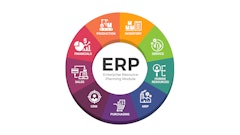To improve supply chain performance focus on improving flow. At a macro level, managing the supply chain is about managing three flows: material, information and money.
One of most important contributions to the management of flow is Goldratt's Theory of Constraints. The application of the theory is summarized in three simple steps: (1) understand the system, (2) identify the constraints and (3) eliminate the constraints. The central tenet of Goldratt's assertion is that eliminating a constrained resource will result in a global improvement in the system. In contrast, improvements made to a non-constrained resource may yield a local benefit but will have no effect on global performance.
Goldratt's theory helps highlight two fundamental points that are relevant to supply chain collaboration: First, as the vertically-integrated enterprise evolves to a virtual network of enterprises, the system (supply chain) is no longer bounded by the "four walls of the enterprise." Any meaningful effort to improve flow must now consider the extended supply chain, which is the new system boundary.
Second, if the constraints (opportunities to improve flow) shift to outside the four walls of the enterprise, then collaboration becomes paramount due to the absence of centralized control.
This is clearly the case in the high-tech industry, which has likely seen the most fragmentation of the vertically-integrated enterprise. Today, with much of the end-to-end supply chain outside the direct control of any single enterprise, the management philosophy of the supply chain has to be collaborative.
Understanding Collaboration: What has changed?
The original goal of supply chain management was to synchronize purchasing, manufacturing, distribution and demand management operations — and the office of the supply chain executive was empowered to bring about alignment with the agenda of the CEO. Having direct control of all functional areas within the vertically-integrated enterprise allowed coordination to be driven from the top-down, as shown in Figure 1.
What is different? However, when the vertically integrated enterprise begins to fragment, the immediate impact is a loss of direct control over all functions. While the goal remains the same, each partner has its own agenda and coordination is not possible without the alignment of multiple CEO agendas. And that is by far the biggest challenge in a multi-enterprise setting.
Us versus them. The shift from vertical to virtual is a structural change, and many companies are still defining their roles in the new business model. Given the prevailing "us versus them" mindset, alignment is often achieved incrementally (as shown in Figure 2), building trust and interdependency at each of the following levels:
- Operational: Collaboration consists of a minimum level of coordination and visibility between companies. The relationship is best described as opportunistic, with very limited process and strategy alignment between companies.
- Tactical: There is a basic level of trust and a desire to create a win-win relationship where partners work together to create value through shared processes with an expanded scope.
- Strategic: This represents the highest level of collaboration where companies create value through alignment of long-term business strategy. Reporting structures may resemble a matrix, and organizational boundaries are often blurred with teams working together to achieve the joint business objectives.
Collaboration Case Study: Improving supply chain flows
While the spirit of collaboration is about working together on common objectives, the desire often starts with a selfish motive, since changing any status quo comes at a cost. Thus, the performance objective at the operational level is typically driven by the partner with greater leverage in the relationship, e.g. "If you want to do business with me, you need to do this at a minimum." And minimum is what one can expect from partners if the benefits are truly one-sided. However, for collaboration to evolve beyond the operational stage, one must recognize that it also requires mutual sharing of risk and rewards.
The following is a brief summary of one company's experience in improving the flow of material, information and money in a distributed virtual enterprise.
Performance: The mutually-agreed business goals to quantify success were:
- Reduce inventory-driven cost (Improve material flow): The primary goal was to dramatically reduce inventory levels.
- Improve procurement cycle time (Improve information flow): Reduce the time required to approve and issue purchase orders.
- Ensure reliability of supply (Improve money flow): Increase revenue by minimizing shortages and delays.
Process: The scope of activities shared between trading partners
- Continuous update of and visibility to projected inventory levels as supply and demand components change.
- Demand and supply matching through automated generation of net requirements (demand) and replenishment plans (supply).
- Web-based real-time negotiation of business objects impacting flow (e.g. Purchase Orders, Replenishment Plans, Forecasts).
- Event-triggered exception management and problem escalation.
Policies: The agreed-upon business rules
- Escalation policies: Management of alerts and exceptions in terms of when, who, how, etc.
- Collaboration cycle: Sequence and frequency of supply and demand planning activities between partners
- Inventory targets: Amount of minimum and maximum inventory to be stored at each location.
- Network management: Sourcing, replenishment, and allocation rules to govern flow of inventory.
Enablers: Capabilities (both technology and non-technology-based) to complete the task
- Private marketplace: Supporting multiple supply chains by enabling process and policy across multiple partners/products/components.
- Single current version of the plan: Access to shared data and plans via a portal for the whole ecosystem.
- Automation: Routine decisions automated through the use of software agents.
- Simulation: Ability to perform what-if analysis and decision support prior to execution.
Results and Closing Thoughts
The key takeaways from the success of the implementation at this client are the following:
- 1. Commitment to the spirit and culture of collaboration: This particular company is a leader in supply chain management. Having implemented flow principles in the 1990s and reaped the benefits, it understood that although the supply chain structure had changed, a truly collaborative philosophy was central to achieving the same level of synchronization that existed in a vertically integrated structure.
2. Commitment to supply chain leadership: The results tell the story — over a billion dollars in inventory reductions, 500 million transactions through the collaboration hub in 2005 and over 200 trading partners using operational collaboration workflows. Such results would not have been possible if the company had not fully embraced its role in the new supply chain structure and continued to be the leader in supply chain vision.
3. Solution maturity: More than five years into its collaborative journey, the company has gained a significant amount of domain expertise in an area of collaborative supply chain management while most companies are still experimenting with pilots. From a technology perspective, the need for a network-oriented hub architecture that existed in parallel with the enterprise-centric enterprise resource planning (ERP) architecture was quickly evident, and the decision to go down this path was validated.
The basic principles that have successfully guided supply chain practitioners in the past are still valid. The basic problem hasn't changed, however the scope of the “system” and the problem domain has been extended to include global partners. Breaking down traditional business models and enabling change in a virtual enterprise is tremendous challenge, but the potential gains make it an inevitable task for those that wish to remain competitive in their chosen markets.
![Pros To Know 2026 [color]](https://img.sdcexec.com/mindful/acbm/workspaces/default/uploads/2025/08/prostoknow-2026-color.mduFvhpgMk.png?auto=format%2Ccompress&bg=fff&fill-color=fff&fit=fill&h=100&q=70&w=100)



![Pros To Know 2026 [color]](https://img.sdcexec.com/mindful/acbm/workspaces/default/uploads/2025/08/prostoknow-2026-color.mduFvhpgMk.png?ar=16%3A9&auto=format%2Ccompress&bg=fff&fill-color=fff&fit=fill&h=135&q=70&w=240)








